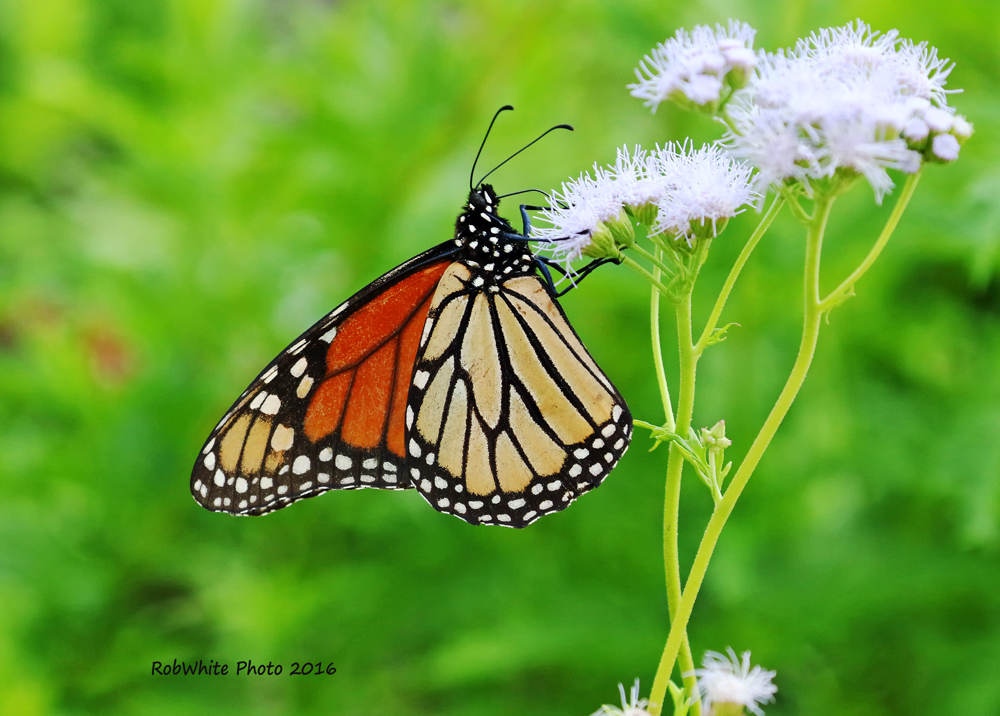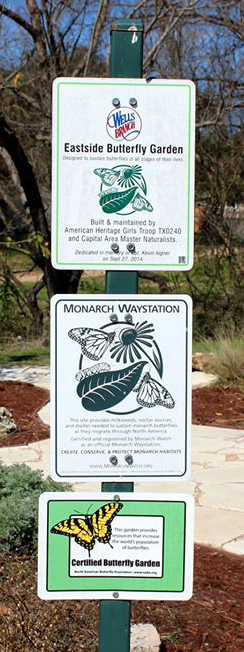Butterfly Facts
 Butterflies are insects.
Butterflies are insects.- A butterfly’s lifecycle is made up of four parts, egg, larva (caterpillars), pupa (chrysalis) and adult.
- Butterflies attach their eggs to leaves with a special glue.
- Most caterpillars are plant eaters (herbivores).
- Fully grown caterpillars attach themselves to a suitable twig or leaf before shedding their outside layer of skin to reveal a hard skin underneath known as a chrysalis.
- An adult butterfly will eventually emerge from the chrysalis where it will wait a few hours for its wings to fill with blood and dry, before flying for the first time.
- Butterflies can live in the adult stage from anywhere between a week and a year, depending on the species.
- Butterflies have four wings.
- Butterflies often have brightly coloured wings with unique patterns made up of tiny scales.
- Most butterflies feed on nectar from flowers.
- Butterflies have taste receptors on their feet.
- Scientists estimate that there are between 15000 and 20000 different species of butterfly.
- Birdwing butterflies have large, angular wings and fly in a similar way to birds.
- Monarch butterflies are known for their long migration. Every year monarch butterflies will travel a great distance (sometimes over 4000 km), females will lay eggs and a new generation of monarchs will travel back, completing the cycle.
 To create your own butterfly habitat, you’ll need:
To create your own butterfly habitat, you’ll need:
- A couple of nice flat rocks in a sunny spot. Since insects are cold blooded, they depend on the sunshine to get their juices going in the morning.
- A shady place where they can hide from the intense heat of mid-day.
- Shelter from strong winds so they can keep their fragile wings from being torn.
- Host plants for their caterpillars to munch on.
- Plants that are nectar sources for the adults.
- Mass plantings of host and nectar plants (not just one or two plants), because the butterflies are often competing with each other and with other species for the same food.
- Having a variety of plants with bright flowers planted, so that as one kind of flower finishes its bloom, another flowering plant comes into bloom, providing a constant food source.
- No pesticides! Not too crazy about herbicides either.
- Keep some leaf litter in an area in the yard to aid the butterflies in winter survival.
- Have mud puddles for them to drink the water and absorb minerals. (They also like rotted fruit.)
- Keep bird feeders in a separate part of the yard, so your butterfly garden doesn’t become a bird buffet.
 Be sure and visit our own WB Eastside Butterfly Garden. Park just north of the WB MUD Annex at 14611 Wells Port and follow the trail east south east. The garden is located across the creek.
Be sure and visit our own WB Eastside Butterfly Garden. Park just north of the WB MUD Annex at 14611 Wells Port and follow the trail east south east. The garden is located across the creek.
Planting for the Monarchs:
Monarchs can use many nectar plants but they will be looking for milkweed to lay their eggs. Our natives are the best to plant: Antelope Horn – Asclepias asperul, Green Milkweed –Asclepias viridis, Swamp Milkweed – Asclepias incarnate
What is wrong with planting Tropical Milkweed (Asclepias Curassavica) here in Central Texas? It is so easy to get and to grow!
Possible problems are:
- Ophryocystis elektroscirrha (OE) disease spores build up on overused Tropical Milkweed plants.
- The Monarchs aren’t finishing their fall migration because viable milkweed is available year-round in the US. Tropical milkweed doesn’t die back on its own in some of our warmer winters.
It is hard to know how big a problem these issues are. The fix is to cut the plant back in late fall when you see a drop in Monarch activity. Tropical Milkweed should be planted along with our native milkweed.
Where to purchase Native Central Texas Milkweed:
The Natural Gardener at 8648 Old Bee Caves Rd, Austin, TX 78735 is advertising that they will have it. Lonestar Nursery is the grower. Call ahead before making the drive: 512.288.6113. Visit their website at: naturalgardeneraustin.com
The Lady Bird Johnson Wildflower Center (wildflower.org/) will be hosting its annual Spring Sale April 7- 9, 2017. For a shopping list of plants that attract butterflies, please visit: wbna.us/community/butterfly-gardens.
Most of these native plants are not going to be at the retail nurseries. However, many can be had at Lady Bird Johnson Wildflower Center Spring Sale – April 7 – 9, 2017. Download the Butterfly Plant List HERE to print for reference.
Giant Swallowtail
- Hop Tree (Ptelea trifoliata)
- Toothache Tree (Zanthoxylum hirsutum)
Eastern Black Swallowtail
- Dutchmen’s Breeches (Thamnosma texana)
- Prairie Parsley (Polytaenia nuttallii)
- Prairie Bishop’s Weed (Bifora americana)
Spicebush Swallowtail
- Spicebush (Lindera benzoin)
Pipevine Swallowtail
- Swan Flower (Aristolochia erecta)
- Texas Snakeroot (Aristolochia serpentaria)
- Texas Pipevine (Aristolochia coryi)
- Woolly Pipevine (Aristolochia tomentosa)
Two-Tailed Tiger Swallowtail
- Hop Tree (Ptelea trifoliata)
Eastern Tiger Swallowtail
- Escarpment Black Cherry (Prunus serotina var. Exemia)
- Texas Ash (Fraxinus texensis)
Red-Spotted Purple
- Escarpment Black Cherry (Prunus serotina var. Exemia)
- Cottonwood (Populus deltoides)
Gulf Fritillary, Zebra Longwing and Julia
- Passionflower (Passiflora lutea)
- Passionflower (Passiflora tennuiloba)
- Passionflower (Passiflora affinis)
- Maypop (Passiflora incarnata)
- Tagua Passionflower (Passiflora foetida)
Variegated Fritillary
- Flax (Linum spp.)
- Passionflower on rare occasions (Passiflora spp.)
Goatweed Butterfly
- Doveweed (Croton monanthogynus)
- Doveweed (Croton texensis)
- Bush Croton (Croton fruticulosus)
Question Mark Butterfly
- Hackberry Trees (Celtis sp.)
- Elm Trees (Ulmus sp.)
Dogface Sulphur
- Kidneywood (Eysenhardtia texana)
- Black Dalea (Dalea frutescens)
- Purple Prairie Clover (Dalea compacta)
Sleepy Orange Sulphur
- Lindheimer’s Senna (Cassia lindheimerii)
- Two-Leaved Senna (Cassia roemeriana)
Dainty Sulphur
- Greenthread (Thelesperma filifolium)
- Navajo Tea (Thelesperma simplicifolium)
Cloudless Sulphur
- Lindheimer’s Senna (Cassia lindheimeri)
- Two-Leaved Senna (Cassia roemeriana)
- Partridge Pea (Chamaecrista fasciculata)
Checkered White
- Virginia Peppergrass (Lepidium virginicum)
- Other plants in the Mustard family
Falcate Orange Tip
- Virginia Peppergrass (Lepidium virginicum)
- Other plants in the Mustard family
Monarch
- Milkweeds (Asclepias spp.)
- Milkweed Vine (Matelea spp.) less frequently
Queen
- Green Milkweed (Asclepias viridis)
- Wand Milkweed (Asclepias viridiflora)
- Texas Milkweed (Asclepias texana)
- Other Asclepias spp. less frequently
- Milkweed Vine (Cynanchum spp.)
- Wavy Leaf Milkweed Vine (Sarcostemma crispum)
- Purple Milkweed Vine (Matelea bifora)
Red Admiral
- Stinging Nettles (Urtica spp.)
- Pellitory or Cucumber Plant (Parietaria pennsylvanica)
Painted Lady
- Texas Thistle (Cirsium texana)
- Plants in the Mallow family
America Painted Lady
- Rabbit Tobacco (Evax spp.)
- Others in the Aster family as well
Buckeye
- Gerardia (Agalinus spp.)
- Plantain (Plantago spp.)
- Paintbrush (Castilleja spp.)
- Wild Petunia (Ruellia spp.)
Mourning Cloak
- Willows (Salix spp.)
- Cottonwood (Populus deltoides)
- Many others used
Bordered Patch
- Cowpen Daisy (Verbesina encelioides)
- Golden-Eye (Viguiera dentata)
- Zexmenia (Zexmenia hispida)
- Many other composites used
Janais Patch
- Flame Acanthus (Aniscanthus quadrifidus)
Texas Crescentspot
- Plants in the Acanthus family
Phaon Crescentspot
- Frogfruit (Phyla spp.)
Pearly Crescentspot
- Aster (Aster spp.)
Vesta Crescentspot
- Hairy Tube Tongue (Siphonoglossa pilosella)
Hackberry Butterfly
Tawny Emperor
Empress Leila
Common Snout
- Hackberry Tree (Celtis spp.)
Silver-Spotted Skipper
- False Indigo (Amorpha fruticosa)
- Texas Indigo Tree (Amorpha roemeriana)
Funereal Duskywing
- Scarlet Pea (Indigofera miniata)
- Rattlebush (Sesbania drummondii)
- Many other legumes
Mottled Duskywing
- Redroot, New Jersey Tea (Ceanothus herbaceous)
Checkered Skipper
- Plants in the Mallow family
Clouded Skipper
- Big Bluestem (Andropogon gerardii)
- Little Bluestem (Schizachyrium scoparium)
- Many Other grass skippers using most any native grass available
Common Wood Nymph
- Big Bluestem (Andropogon gerardii)
- Purpletop Tridens (Tridens flavus)
Red Satyr
- An assortment of native grasses
Gray Hairstreak
- Many different host plants
Ceraunus Blue
- Scarlet Pea (Indigofera miniata)
- Bundleflower (Desmanthus spp.)
- Prairie Clovers (Dalea spp.)
Reakirt’s Blue
- Bundlefower (Desmanthus spp.)
Great Blue Hairstreak
- Mistletoe (Phoradendron tomentosum)